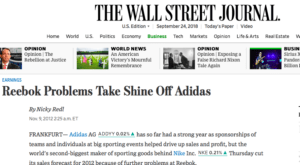FRANKFURT—Adidas AG ADS.XE +0.19% has so far had a strong year as sponsorships of teams and individuals at big sporting events helped drive up sales and profit, but the world’s second-biggest maker of sporting goods behind Nike Inc. NKE +0.49% Thursday cut its sales forecast for 2012 because of further problems at Reebok.
The German company acquired Reebok in 2006, and has struggled to power the brand ever since. Most recently, Reebok lost out to Nike on a contract to supply products to the U.S. National Football League, is being hit by a player lockout in the National Hockey League and is continuing to sort out problems in India after “commercial irregularities” were discovered.
Reebok’s woes mean that while Adidas is competing strongly against Nike in Europe, Asia and fast-growing markets such as China and Latin America, it is losing ground in the U.S., the world’s biggest sports-apparel market. The group’s sales fell 4.7% in the U.S. in the third quarter, predominantly because of Reebok’s poor performance, compared with a 23% increase for Nike in North America in its most recent quarter.
“I don’t think the Adidas brand is losing ground to Nike, but Reebok is,” said Barclays analyst Julian Easthope.
Adidas said it now expects group sales to rise by a high single-digit rate in 2012, compared with its previous forecast for a rate approaching 10%. The company in September cut its midterm sales outlook for Reebok to €2 billion ($2.55 billion) in 2015, from €3 billion, but said it expected the Adidas brand to compensate.
The company’s shares were down Friday afternoon in Frankfurt as the lowered sales guidance took the shine off third-quarter results that otherwise beat the market’s expectations.
Adidas’ net profit rose 14% on the year in the third quarter to €344 million as sales rose 11% to €4.17 billion, buoyed by strong demand in Asia and Eastern European markets. The company benefited from its sponsorship of prominent teams and individuals at the summer Olympics in London and the European soccer championships. It said it expects net profit in 2012 to rise between 15% and 17% to between €770 million and €785 million.
Part of Reebok’s problems relate to an continuing dispute in the National Hockey League. Owners of the league’s franchises barred members of the NHL Players’ Association from playing after failing to reach a new deal on contracts, prompting the cancellation of all games since preseason started Sept. 19 up until the end of November, and the dispute is continuing. Reebok is the official outfitter to the league.
U.S. sales fell 4.7% at Adidas while Nike’s rose 23% in North America.
That followed the NFL’s decision that Nike would replace Reebok as the league’s exclusive maker of on-field apparel and fan gear. The terms of the five-year Nike deal weren’t disclosed, but Adidas has said the loss of the license agreement, which Reebok has held for the past decade, will result in an estimated $200 million to $250 million a year in lost revenue for Reebok.
Adidas also said problems at Reebok’s Indian unit would continue affecting results in the fourth quarter, without giving details. The company in May filed a criminal complaint against the former chief of its Indian operations and another former senior employee for alleged financial and commercial irregularities that resulted in the company taking a charge of $155 million plus a further $87 million in restructuring costs.
Several attempts to reinvent and reposition Reebok to take advantage of the U.S. market have failed to work. The latest plan is to market Reebok as a fitness-only brand. In September, Reebok marketing chief Matt O’Toole assured investors the brand’s new structure “will bring more focus and a deeper product offering and will provide better commercial opportunities as we turn the corner into 2013.”
But Reebok’s problems are deeply rooted and sales were down 6% excluding the loss of licenses and the problems in its Indian unit.
Adidas Chief Executive Herbert Hainer conceded the Reebok brand’s performance was “by no means satisfactory,” but pointed out the sales fall was an improvement from the second-quarter decline of 10%.
Mr. Hainer was more positive about the group’s prospects, predicting Adidas would increase sales, boost its profit margin and see earnings rise by a significant double-digit percentage in 2013.
This article was published by The Wall Street Journal on November 9, 2012.

